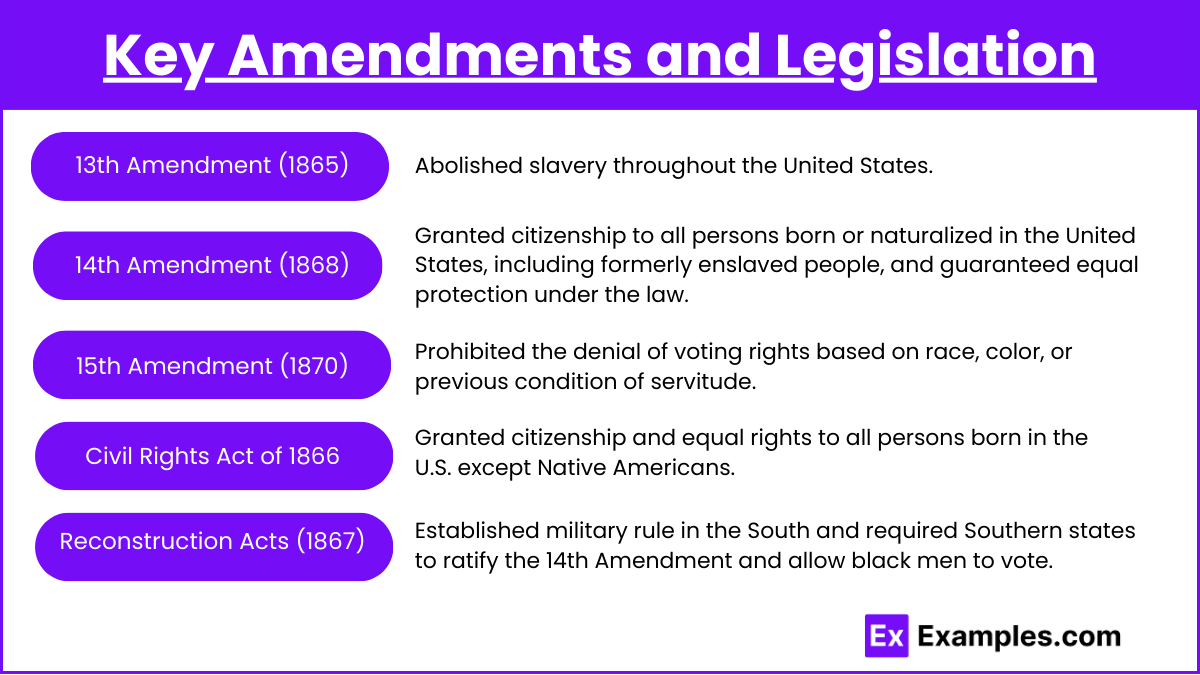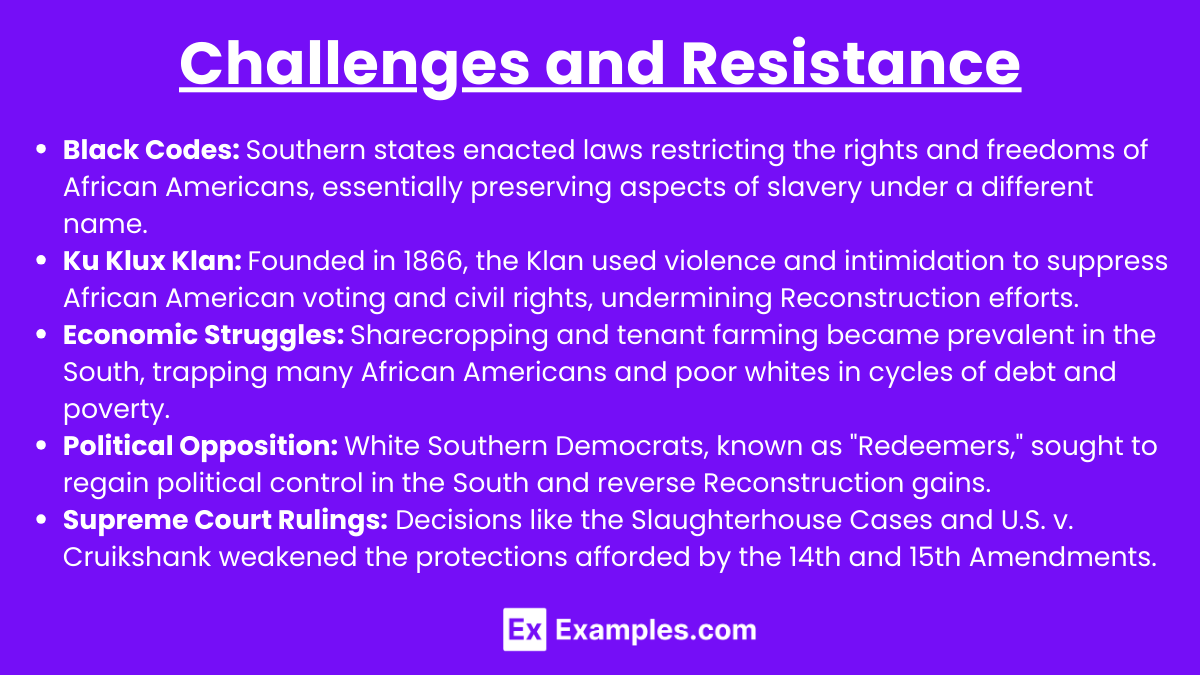In AP United States History, Reconstruction refers to the period from 1865 to 1877, following the Civil War, when the United States sought to reintegrate the Southern states into the Union and address the status of formerly enslaved people. This era involved significant political, social, and economic efforts, including the passage of the 13th, 14th, and 15th Amendments. Despite initial progress, Reconstruction faced fierce resistance, leading to its eventual failure and the establishment of Jim Crow laws in the South.
Learning Objectives
The learning objectives for the topic “Reconstruction” will include the ability to analyze the goals, successes, and failures of Reconstruction, particularly regarding the reintegration of Southern states and the rights of formerly enslaved people. You will be expected to evaluate key legislation, including the 13th, 14th, and 15th Amendments, and understand the resistance faced from Southern states. Additionally, you will be required to assess the long-term impact of Reconstruction on race relations and federal-state power dynamics in the United States.
Phases of Reconstruction

Presidential Reconstruction (1865-1867)
Led by Presidents Abraham Lincoln and Andrew Johnson, this phase sought a lenient approach to reuniting the nation. Lincoln’s Ten Percent Plan allowed Southern states to rejoin the Union if 10% of their voters swore loyalty to the Union and accepted emancipation. After Lincoln’s assassination, Johnson continued a lenient policy but faced criticism for being too conciliatory toward the South and for allowing the enactment of Black Codes, laws that restricted the freedom of African Americans.
Radical Reconstruction (1867-1877)
Frustrated with Johnson’s leniency, Radical Republicans in Congress took control of Reconstruction. They passed the Reconstruction Acts of 1867, which divided the South into five military districts and required states to ratify the 14th Amendment, guaranteeing citizenship and equal protection under the law for African Americans, and to provide suffrage for black men. This phase also saw the establishment of the Freedmen’s Bureau, which provided assistance to formerly enslaved people and poor whites.
The End of Reconstruction (1877)
Reconstruction gradually waned due to Southern resistance, economic concerns, and waning Northern commitment. The Compromise of 1877, which resolved the disputed 1876 presidential election, marked the official end of Reconstruction. In exchange for conceding the presidency to Republican Rutherford B. Hayes, federal troops were withdrawn from the South, effectively ending efforts to enforce Reconstruction policies.
Key Amendments and Legislation

13th Amendment (1865): Abolished slavery throughout the United States.
14th Amendment (1868): Granted citizenship to all persons born or naturalized in the United States, including formerly enslaved people, and guaranteed equal protection under the law.
15th Amendment (1870): Prohibited the denial of voting rights based on race, color, or previous condition of servitude.
Civil Rights Act of 1866: Granted citizenship and equal rights to all persons born in the U.S. except Native Americans.
Reconstruction Acts (1867): Established military rule in the South and required Southern states to ratify the 14th Amendment and allow black men to vote.
Challenges and Resistance

Black Codes: Southern states enacted laws restricting the rights and freedoms of African Americans, essentially preserving aspects of slavery under a different name.
Ku Klux Klan: Founded in 1866, the Klan used violence and intimidation to suppress African American voting and civil rights, undermining Reconstruction efforts.
Economic Struggles: Sharecropping and tenant farming became prevalent in the South, trapping many African Americans and poor whites in cycles of debt and poverty.
Political Opposition: White Southern Democrats, known as “Redeemers,” sought to regain political control in the South and reverse Reconstruction gains.
Supreme Court Rulings: Decisions like the Slaughterhouse Cases and U.S. v. Cruikshank weakened the protections afforded by the 14th and 15th Amendments.
Examples
- Freedmen’s Bureau: Provided education, food, housing, and legal assistance to formerly enslaved people and poor whites.
- Carpetbaggers and Scalawags: Northern Republicans (carpetbaggers) and Southern Unionists (scalawags) who supported Reconstruction were often vilified by Southern Democrats.
- The Election of 1866: Republicans gained control of Congress, enabling the passage of Radical Reconstruction policies over President Johnson’s vetoes.
- Compromise of 1877: Ended Reconstruction in exchange for Rutherford B. Hayes becoming president, leading to the withdrawal of federal troops from the South.
- Jim Crow Laws: Enacted after Reconstruction ended, these laws institutionalized racial segregation and disenfranchised African Americans in the South.
MCQs:
- What was the primary goal of the Freedmen’s Bureau?
- A) To assist former Confederate soldiers
- B) To provide aid to formerly enslaved people and poor whites
- C) To enforce Black Codes in the South
- D) To organize Northern industrial workers
- Answer: B) To provide aid to formerly enslaved people and poor whites
- Explanation: The Freedmen’s Bureau was established to assist formerly enslaved people and poor whites with food, housing, education, and legal matters during Reconstruction.
- Which amendment granted citizenship and equal protection under the law to all persons born or naturalized in the United States?
- A) 13th Amendment
- B) 14th Amendment
- C) 15th Amendment
- D) 19th Amendment
- Answer: B) 14th Amendment
- Explanation: The 14th Amendment granted citizenship to all persons born or naturalized in the U.S. and guaranteed equal protection under the law, a key part of Reconstruction’s efforts to secure civil rights for African Americans.
- What event marked the official end of Reconstruction?
- A) The passing of the 15th Amendment
- B) The Compromise of 1877
- C) The assassination of Abraham Lincoln
- D) The election of Ulysses S. Grant
- Answer: B) The Compromise of 1877
- Explanation: The Compromise of 1877 ended Reconstruction by withdrawing federal troops from the South in exchange for Rutherford B. Hayes becoming president, leading to the return of Democratic control in the South.


